Aspirational Thinking: Creating ASPIRE
The ASPIRE (Accessible Statements Promoting Improved Reading Experience) project was launched in 2018 as a crowdsourced project to evaluate the quality of accessibility statements in the publishing industry. ASPIRE has since developed into a fully responsive service and in this article, we trace the story of the ASPIRE from its small beginnings to becoming an industry standard driving increased transparency across the industry.
The Origins of ASPIRE
Accessibility
ASPIRE started life as a crowdsourced project supported by librarians, publishers, and ebook vendors. The aim was to create a unique resource that provided a health check on the state of accessibility information in the publishing ecosystem. The ASPIRE working group designed a framework of testing criteria and then crowdsourced the evaluation process across participating UK libraries.
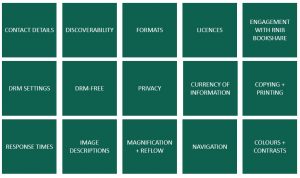
The ASPIRE criteria
The results from the initial ASPIRE project offered an eye-opening insight into the state of accessibility within the publishing community and we shall explore those results in due course.
Legal
The driving force behind the creation of ASPIRE was the impending legal changes in the UK. In September 2018, the UK adopted the EU Directive on Public Sector Web Accessibility into UK law under the guise of the Public Sector Bodies (Websites and Mobile Applications) (No.2) Accessibility Regulations 2018. This new legislation applied to all publicly funded organisations in the UK, including further and higher education institutions. It introduced two key elements as legal obligations:
- Meeting the “accessibility requirement.”
- Requiring accessibility statements.
The web accessibility legislation states that (Part 3.9.1.a):
A website of a public sector body will be presumed to be in conformity with the accessibility requirement to the extent that it meets harmonised standards.
Under the regulations, organisations that comply with WCAG 2.1 AA will fulfil their accessibility requirements. This legal change impacts all areas of the digital estate within a university or college. The Government Digital Services (GDS) states that if you pay for or subscribe to content you are “funding” it and therefore you are responsible for it meeting accessibility standards, as well as being responsible for providing an accessibility statement.
The GDS model accessibility statement outlines the key elements relevant to both the supplier and the university/college:
- an explanation of those parts of the content that are not accessible and the reasons why.
- a description of any accessible alternatives.
- contact information.
- Links to a complaints/escalation process.
Each of the first three elements is addressed by the ASPIRE review. The fourth is unique to each education provider. As a result, suppliers providing the kind of user focused guidance that would give them a high ASPIRE score are also creating the core of an accessibility statement that a university or college requires to meet their own obligations under the new legislation. By providing up-to-date accessibility statements suppliers are helping librarians and also providing an accurate reflection of their products and services, to their own benefit and to the benefit of their customers.
The ASPIRE Results: Information Silence
The overarching theme of the initial ASPIRE results was missing information within the accessibility statements. On average publishers were missing 87% of the information required and platforms were missing 78%. This missing information is critical to making informed procurement decisions and the effective use of the digital content, and it clearly illustrated that content providers were failing to tell the whole story of their content.

The Holes in the Statements
The three key findings from the ASPIRE data were as follows:
- Most suppliers provide far less accessibility information than a university or college requires in order to support their learners efficiently.
- Most suppliers are missing a significant marketing opportunity because their digital products almost invariably have accessibility benefits (compared to hard copy print) that could – and should—be marketed.
- Even when a supplier has an accessible product and useful accessibility information, the information is often hard to find or is spread across unrelated parts of the website, creating a significant variability in end user experience.
The ASPIRE project highlighted the lack of information made available by content providers, but it should be noted that it does not necessarily reflect the work and resources that are being invested in accessibility. A common response from content providers was that the survey helped them understand that they were not telling the story of the work they had dedicated to implementing inclusive publishing practices. An accessibility statement helps to promote this work and this marketing opportunity is often being overlooked. As Vanessa Boddington of VitalSource stated
The audit helped us refine the information we present to the public. Whilst we had focused on making our content as technically accessible as possible…how would users know how we can help unless we tell them?
In the face of the data, content providers were coming to understand that their message was not being heard.
Renewing ASPIRE
A key takeaway from the initial ASPIRE project was that there was demand for an ongoing service to meet the needs of publishers, platforms and users. An annual crowdsourced approach is unwieldy and ultimately unsustainable. To be truly effective ASPIRE needed to be transformed into a robust, scalable, sustainable and responsive service, to meet the publishing industry’s increased focus on accessibility.
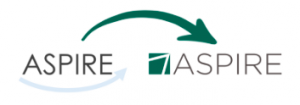
The Development of ASPIRE
The new re-calibrated service, launched in August 2019 under the wing of textBOX, is responsive to the needs of content providers and provides a complete ASPIREreview within 5 business days. With this shift in focus to a fully-fledged accreditation service, ASPIRE can truly reflect the work of content providers and provide a window on their content for librarians and content purchasers. To further encourage accessible practices, we are also donating 10% of all profits from the new ASPIRE service to the UK Literacy Association Donkey Library scheme.
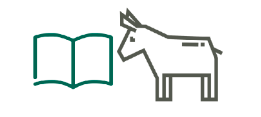
UK Literacy Association Donkey Library
The ASPIRE Process
The ASPIRE service involves the following 4 stages:
ASPIREreview
The accessibility statement is reviewed in-depth by the ASPIRE team.
ASPIREscore
The accessibility statement is scored against each ASPIRE criteria.
ASPIREverified
The accessibility statement is accredited, and the approved review is ranked on the public ASPIRElist.
ASPIREstory
In addition to each ASPIREscore being announced to the market via Twitter, LinkedIn and library listservs, the publisher or platform is also able to submit an ASPIREstory detailing the importance of accessibility within their workflow. This marketing opportunity is a free service.
The Benefits of ASPIRE
The ASPIRE service fosters positive engagement within the publishing community across a range of perspectives:
The Librarian Perspective
ASPIRE helps librarians make informed procurement decisions and frees them from the unnecessary burden of writing accessibility statements as required by law.
The User Perspective
By creating informative accessibility statements, publishers and platforms are engaging with their customer base and highlighting their valuable content and innovative and useful features.
The Provider Perspective
Publishers and platforms invest heavily in accessibility. A thoughtful and comprehensive accessibility statement is an opportunity to tell their story, attract every customer and drive sales.
The Road Ahead
The new ASPIRE service has received a positive response since its launch in September 2019. Kogan Page posted the highest publisher score of 93% and became the first ASPIREverified Gold publisher. In recent months, ProQuest (78%), Cambridge Core (91%), and VitalSource (97%) have all achieved Gold status on the ASPIRElist for platforms. These scores are remarkable when contrasted with the average scores across the industry (14% for publishers and 24% for platforms, see Figures 5 and 6 below) and illustrate the commitment of these companies to accessible content and their users. The ASPIRE mission is to help every publisher and vendor reach a similar level.
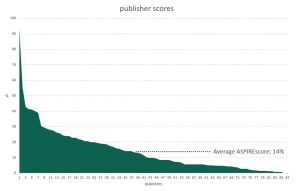
Publisher ASPIREscores by %
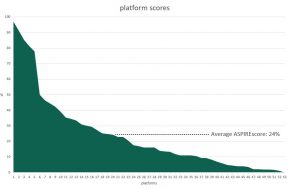
Platform ASPIREscores by %
Final Thoughts
An accessibility statement tells the story of a publisher’s content or a vendor’s platform. A book would never be published without a cover or a blurb to provide insight to the customer. By overlooking their accessibility statement, companies are failing to advertise their work and tell their story. The ASPIRE service helps guide publishers and platforms and amplifies their message. We help the publishing industry tell their story and open doors for their customers.

Opening Doors, Enabling Access
Learn more about ASPIRE and make your statement today.
This article was kindly submitted by Huw Alexander, textBOX digital (an Inclusive Publishing Partner) and Alistair McNaught, Alistair McNaught Consultancy, the team giving ASPIRE a long term home.

